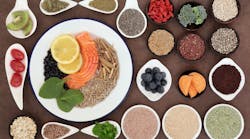Oral health and nutrition: Do your patients understand the connection?
When it comes to nutrition, patients may not be aware of hidden sugars in foods, the effects of fermentable carbohydrates such as crackers and chips, and how these foods are retained in the mouth or “stick” to the teeth. Our advice to “avoid sticky foods” is inadequate because patients don’t entirely understand the tooth retention of food, how it sticks to their teeth.1
Patients also don’t always know about the acidity levels of foods and drinks and the negative impact these can have on their oral health. The lack of certain vitamins, minerals, and nutrients can result in oral conditions such as angular cheilosis, burning sensation in the mouth, papillary atrophy, altered taste, and dysphagia. Identifying a vitamin deficiency through early oral symptoms can lead to intervention before serious systemic damage can occur.2 Evidence supports the role nutrition plays in periodontal health.3
Each time we see a patient, we have the opportunity to increase dental health literacy and encourage change associated with healthier behaviors. This means working with patients regarding dietary habits that may negatively impact oral health and increase the risk of oral disease.
In recent years, dental hygiene visits have become more comprehensive and health-focused, and this adds value beyond simply “cleaning teeth.” Our time is constrained when our appointments are more complex, but we can gain more traction and influence in a shorter time when we see opportunities to engage patients. We can use strategies that are simple and patient driven. It’s easier and more relevant for patients when they implement small changes with goals they choose based on their motivations and readiness to change.4,5
How to have effective conversations about nutrition
Flip the script
Look for opportunities that will foster conversations with patients as active participants. These interactions are two-way dialogues and are more likely to motivate change. Compare this to the low success rate associated with traditional patient education, which often comes across as a lecture where we tell them what to do.6
Engage patients when they ask questions, make a comment, or state a concern about the effects of their diet. If someone says, “I always get cavities, but I brush my teeth,” you might reply, “I hear your concern and that sounds frustrating. What do you think is causing it? Would you mind sharing a typical day regarding what and when you eat? What changes would you be willing to make if you knew that those changes could possibly address your concern?”
Allow the patient to reply to each question and listen without interrupting or thinking about your next question. Affirm or summarize what the patient said, which is a form of active listening. This can help us better connect and ensure we understand what patients are saying. People who feel listened to are more likely to listen in return.
Reflect on how you ask questions. If you ask, “Do you eat a lot of sugary foods and drinks?” you will get a short answer. The patient may not realize that consuming pretzels throughout the day increases caries risk, so you’ve missed an opportunity. Ask open-ended questions with the goal of having a conversation.
In my experience, this approach does not take any more time than traditional patient education. It’s often a more effective way to get to the relevant points. It also addresses specific areas based on individual situations and readiness. This can result in better patient success and less provider frustration.7
Ask permission instead of saying “you should”
How do you respond when someone tells you to do something, particularly something you’re not interested in or ready to do. For most of us, this isn’t motivating and can have the opposite effect. You can share information with a patient by asking their permission first, which is a great way to keep a dialogue going. “Do you mind if I share something with you that might help?” Also, it’s helpful to direct suggestions to specific concerns or areas they’re willing to change versus assuming they want the same things you do.
Champion small changes
Evidence supports that simple and sustainable change can happen when the goal set by the patient is based on one or two items they’re willing to try.7 Changes in habits often take place incrementally; small changes are met with a greater success rate, which leads to large changes and long-term success.6 Substituting even one thing can help motivate additional change.
Small dietary changes can be as simple as:
- Pairing cariogenic food (like crackers) with noncariogenic food (such as hard cheese, which has cariostatic properties).8
- Substituting water with xylitol for sweetened beverages (taste equivalent is 1:1 with sugar) or alternate water (or rinse with water) when consuming low pH beverages. Remind patients to drink cariogenic beverages during a short period rather than sipping them all day.
- Consuming cariogenic foods and drinks that patients aren’t ready to give up only at mealtimes.
- Consuming milk with foods such as cookies or pastries because milk protein is an effective buffer.9
- Saliva that is rich in arginine elevates pH reduces the risks of demineralization.10,11 Arginine is in foods such as sources of protein like white meat and soy; whole eggs; unsweetened nuts, seeds such as sunflower, sesame, and pumpkin (these can also serve as a good substitution for cariogenic salty snacks like chips, crackers, and pretzels); chickpeas and lentils; dairy products such as unsweetened milk, yogurt, and hard cheese; and whole grains such as brown rice and oats. These complex carbohydrates give bacteria less digestible food sources.
- Including fruit sources like grapes and surprisingly, raisins, which have long had the reputation of being cariogenic due to their sticky texture. Raisins contain natural phytochemicals that suppress the growth of selected bacteria such as mutans, and they interfere with adherence of cariogenic bacteria.12,13 Raisins and dried fruits are less retentive than cookies, crackers, and chips.1 Dark colored berries such as cranberries and blueberries have phytonutrients that prevent the adherence of bacteria.14
When patients share what they’re eating, look for areas where they could use more balance, then work together to come up with ideas on how to fill the nutritional gaps. For patients who like candy, recommend they substitute it with xylitol gum or mints (with xylitol as a leading ingredient), or therapeutic candies that can increase the pH (like Basic Bites, which also contain arginine).
The effective therapeutic dose for xylitol is 6-10 grams per day. Gums and mints should be taken three to five times per day, and gum should be discarded after about 15 minutes. Xylitol can be incorporated into the diet as a 1:1 substitute for sugar. Adults can tolerate between 10-30 grams per day, and adults should not consume more than 50 grams per day. Xylitol should be phased in slowly to avoid gastrointestinal issues.15 Xylitol is toxic to pets, even in small doses, so it is important to tell patients this.
Erythritol has also been studied as a 1:1 substitute for sugar that inhibits the grown of S. mutans and decreases biofilm adherence, without the same gastrointestinal effects as xylitol.16 It’s important to follow up with patients at subsequent interactions to celebrate successes and strategize as a team to seek opportunities for more success.
Incorporate conversation starters
Promote opportunities for engagement with visual tools. You’d be surprised how a chart with the pH of drinks and bottled waters can generate conversations. Food lists with the number of teaspoons of sugar per serving, or tips for reading food labels and the various names for sugar, also help develop patient interest. Photos of “unlikely suspects,” foods that patients may not realize can be harmful to their teeth, can help educate them about lowering dietary risk factors for dental disease.
We know diet can be a good ally in better oral and overall health. Patients don’t have the knowledge that we do about nutrition. Patient-centered conversations versus us telling them what to do will lead to more healthy changes.6 We need to engage patients from a place of curiosity. When we let patients guide conversations, we’ll see a greater impact, which results in more satisfaction for patients and providers.
References
- Kashket S, Van Houte J, Lopez LR, Stocks S. Lack of correlation between food retention on the human dentition and consumer perception of food stickiness. J Dent Research. 1991;70(10):1314-1319. doi:10.1177/00220345910700100101
- Sheetal A, Hiremath VK, Patil AG, Sajjansetty S, Kumar SR. Malnutrition and its oral outcome - a review. J Clin Diagn Res. 2013;7(1):178-80. doi:10.7860/JCDR/2012/5104.2702. Epub 2013 Jan 1.
- Martinon P, Fraticelli L, Giboreau A, Dussart C, Bourgeois D, Carrouel F. Nutrition as a key modifiable factor for periodontitis and main chronic diseases. J Clin Med. 2021;10(2):197. doi:10.3390/jcm10020197
- Gardner B, Lally P, Wardle J. Making health habitual: the psychology of 'habit-formation' and general practice. Br J Gen Pract. 2012;62(605):664-666. doi:10.3399/bjgp12X659466
- Bergeson SC, Dean JD. A systems approach to patient-centered care. JAMA. 2006;296(23):2848–2851. doi:10.1001/jama.296.23.2848
- Rosegren DB. Building motivational interviewing skills: a practitioner workbook. The Guilford Press; 2018.
- Miller WR, Rollnick S, et al. Motivational interviewing: helping people change. The Guilford press; 2012.
- Gul P, Akgul N, Seven N. Anticariogenic potential of white cheese, xylitol chewing gum, and black tea. Eur J Dent. 2018;12(2):199-203. doi:10.4103/ejd.ejd_4_18
- Shetty V, Hegde AM, Nandan S, Shetty S. Caries protective agents in human milk and bovine milk: an in vitroJ Clin Pediatr Dent. 2011;35:389–392.
- Agnello M, Cen L, Tran NC, Shi W, McLean JS, He X. Arginine improves pH homeostasis via metabolism and microbiome modulation. J Dent Res. 2017;96(8):924-930. doi:10.1177/0022034517707512
- Nascimento MM, Burne RA. Caries prevention by arginine metabolism in oral biofilms: translating science into clinical success. Curr Oral Health Rep 1. 2014;(1)79–85. https://doi.org/10.1007/s40496-013-0007-2
- Greger M. Raisins and dental health. Nutrition facts. October 16, 2018. Last updated: October 2, 2018. https://nutritionfacts.org/2018/10/16/raisins-and-dental-health/
- Wong A, Young DA, Emmanouil DE, Wong LM, Waters AR, Booth MT. Raisins and oral health. J Food Sci. 2013;(6);78. Suppl 1:A26-9. doi:10.1111/1750-3841.12152
- Cranberries and blueberries – why certain fruit extracts could provide the key to fighting tooth decay. Dentalhealthorg. Accessed Nov. 2, 2022. https://www.dentalhealth.org/news/cranberries-and-blueberries-why-certain-fruit-extracts-could-provide-the-key-to-fighting-tooth-decay
- Nayak PA, Nayak UA, Khandelwal V. The effect of xylitol on dental caries and oral flora. Clin Cosmet Investig Dent. 2014;(10);6:89-94. doi:10.2147/CCIDE.S55761
- de Cock P, Mäkinen K, Honkala E, Saag M, Kennepohl E, Eapen A. Erythritol is more effective than xylitol and sorbitol in managing oral health endpoints. Int J Dent. 2016;(8)2016:9868421. doi:10.1155/2016/9868421







